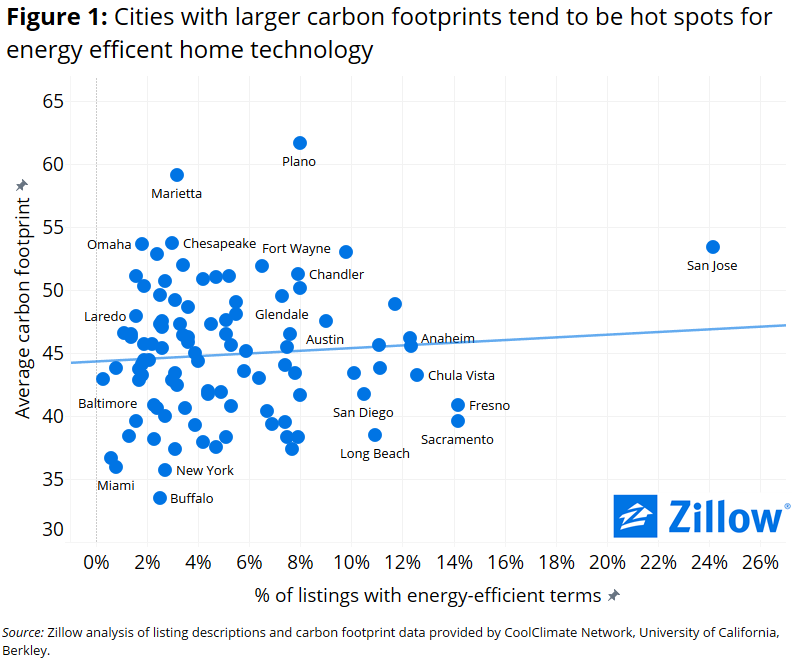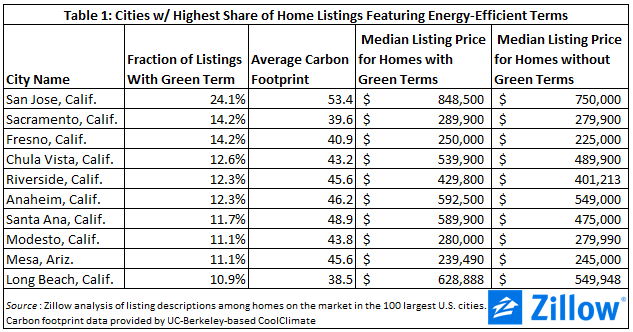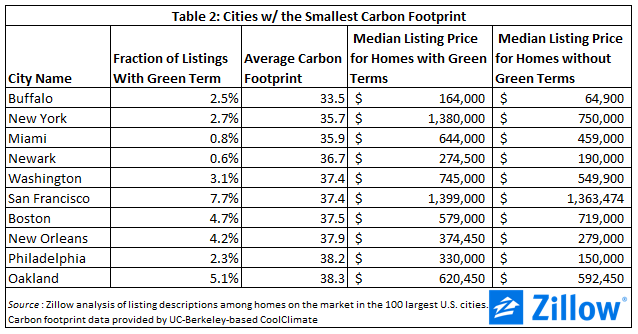- California cities have some of the most energy efficient homes but not the lowest carbon footprint.
- San Jose, Calif. has the greatest percentage of home listings with energy efficiency technology, at 24.1 percent, but the fifth largest carbon footprint.
- East Coast cities top the list of places with the smallest carbon footprint. Buffalo, N.Y. has the smallest carbon footprint, but only 2.5 percent of listings feature energy efficient terms.
- Millennials are more interested in making upgrades to enhance their home’s energy efficiency than other generations.
As it turns out, cities with the most homes for sale that advertise eco-friendly amenities – think solar panels, double-paned windows and energy-efficient appliances – are also the cities that need those amenities most, because their carbon footprints tend to be larger.
Zillow analyzed the listing descriptions of homes for sale in the country’s 100 largest cities and the U.S. as a whole, looking for any of 79 different energy-related and/or otherwise eco-friendly terms, in order to determine which cities have the greatest share of green or green-leaning homes for sale.[1] We also analyzed carbon footprint data for these cities as provided by University of California, Berkeley-based CoolClimate Network.
 We found that cities with some of the largest carbon footprints are also hot spots for energy-efficient home technology. The correlation is small, but noticeable (figure 1). We also discovered that home buyers looking for these kinds of green amenities should, in general, be prepared to pay a sometimes substantial premium.
We found that cities with some of the largest carbon footprints are also hot spots for energy-efficient home technology. The correlation is small, but noticeable (figure 1). We also discovered that home buyers looking for these kinds of green amenities should, in general, be prepared to pay a sometimes substantial premium.
In general, California cities top the list for energy-efficient homes, but not for low carbon footprints. Of the 100 largest cities nationwide, San Jose (24.1 percent) has – by far – the greatest share of home listing descriptions featuring energy efficient terms. Next on the list were Sacramento (14.2 percent) and Fresno (14.2 percent), also both in California. Overall, nine of the 10 cities with the most home listings that mention green amenities are in California, with the exception of Mesa, Ariz. (table 1).
 Large cities with the smallest carbon footprint, however, are concentrated in the dense Northeast Corridor stretching from Washington, D.C., north through Boston. Buffalo, N.Y., has the smallest carbon footprint, followed by a series of large, dense cities – several of which feature comprehensive public-transit networks – including New York City, San Francisco and Philadelphia (table 2).
Large cities with the smallest carbon footprint, however, are concentrated in the dense Northeast Corridor stretching from Washington, D.C., north through Boston. Buffalo, N.Y., has the smallest carbon footprint, followed by a series of large, dense cities – several of which feature comprehensive public-transit networks – including New York City, San Francisco and Philadelphia (table 2).
 Nationwide, the median list price of homes that advertise energy-efficient technology is 62.1 percent higher than for homes that do not ($299,900 for homes that do advertise green technology, $185,000 for homes that do not). Interestingly, the median listing price for green-friendly homes is actually lower than for homes without eco-friendly amenities in eight of the 100 largest U.S. cities, including San Diego (eco-friendly homes are listed for $3,000 less than non-eco-friendly homes), Los Angeles ($25,100 less for eco-friendly homes) and Boston ($140,000 less). In the case of Los Angeles and Boston, this disparity could be explained by a premium put on local historic homes, which may be more likely to be listed for more money and less likely to have been upgraded with green features in recent years.
Nationwide, the median list price of homes that advertise energy-efficient technology is 62.1 percent higher than for homes that do not ($299,900 for homes that do advertise green technology, $185,000 for homes that do not). Interestingly, the median listing price for green-friendly homes is actually lower than for homes without eco-friendly amenities in eight of the 100 largest U.S. cities, including San Diego (eco-friendly homes are listed for $3,000 less than non-eco-friendly homes), Los Angeles ($25,100 less for eco-friendly homes) and Boston ($140,000 less). In the case of Los Angeles and Boston, this disparity could be explained by a premium put on local historic homes, which may be more likely to be listed for more money and less likely to have been upgraded with green features in recent years.
 In cities like San Diego, however, this could be driven by the supply of homes that include eco-friendly amenities – more than one in ten (10.5 percent) of homes listed in San Diego boast green amenities. Across the top 100 cities nationwide, the premium on homes with eco-friendly amenities generally decreases as the share of homes listed for sale with energy-efficient technology increases (figure 2). In other words, because there are more green homes available in some markets, buyers likely aren’t as willing to pay as much of a premium to snag one.
In cities like San Diego, however, this could be driven by the supply of homes that include eco-friendly amenities – more than one in ten (10.5 percent) of homes listed in San Diego boast green amenities. Across the top 100 cities nationwide, the premium on homes with eco-friendly amenities generally decreases as the share of homes listed for sale with energy-efficient technology increases (figure 2). In other words, because there are more green homes available in some markets, buyers likely aren’t as willing to pay as much of a premium to snag one.
As green technology evolves and becomes less expensive, and as younger generations raised on the specter of global warming and the need to protect the environment begin to enter the home buying market, it’s likely that energy-efficiency in homes will become a bigger selling point in coming years. According to the Zillow Group Report on Consumer Housing Trends, the energy efficiency of newly built homes is the main driver in attracting buyers to new construction. The same survey found that millennials are more interested than other generations in making upgrades to enhance their home’s energy efficiency.
[1] Those terms included: Absorber, Absorption chiller, Absorption refrigeration, Accumulator, Active solar heater, Active solar heating, Active solar power, Air collector, Air diffuser, Air pollution control, Airlock entry, Air-source heat pump, Air-to-water heat pump, Attached greenhouse, Attic fan, Concrete construction, Daylighting, Double pane window, Dual flush toilets, Dual pane, Efficient, Electric thermostat timer, Energy efficient appliances, Energy efficient light fixtures, Energy recover ventilator, Energy Star, Engineered wood products, Enhanced air filtration, Geo thermal heat system, Green roof, Green Seal, High Efficiency Furnace, Home Energy Rating System, Low emissivity window films, Low emittance doors, Low emittance windows, Low flow fixture, Low flow solar water heating system, Low flow toilet, Low flush toilet, Masonry stove, Movable insulation, National Green Building Standard, Natural cooling, Occupancy sensor, On demand water circulation pump, On demand water heater, Panel radiator, Parabolic dish, Passive solar, Passive solar building design, Passive solar heater, Passive solar home, Pellet stove, Perimeter heating, Permeable pavement, Photovoltaic, Programmable thermostats, Radiant ceiling panel, Radiant floor, Radiant heating system, Radiative cooling, Radient, Sealed combustion fireplace, Sealed combustion woodstove, Solar, Solar assisted hot water, Solar domestic hot water, Solar electric system, Solar hot water, Solar hot water heat, Solar panel, Solar pool equipment, Solar wall, Sustainable flooring, Tankless, Thermal, Trombe wall, Wind power




